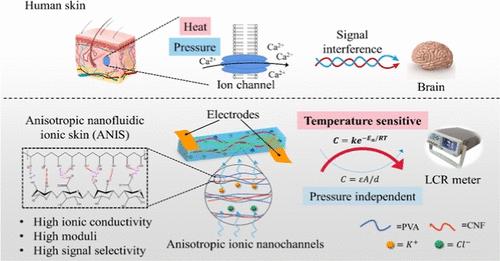Anisotropic Nanofluidic Ionic Skin for Pressure-Independent Thermosensing
IF 16
1区 材料科学
Q1 CHEMISTRY, MULTIDISCIPLINARY
引用次数: 0
Abstract
Ionic skin can mimic human skin to sense both temperature and pressure simultaneously. However, a significant challenge remains in creating precise ionic skins resistant to external stimuli interference when subjected to pressure. In this study, we present an innovative approach to address this challenge by introducing a highly anisotropic nanofluidic ionic skin (ANIS) composed of carboxylated cellulose nanofibril (CNF)-reinforced poly(vinyl alcohol) (PVA) nanofibrillar network achieved through a straightforward one-step hot drawing method. The inherent anisotropic nanostructures endowed the ANIS with a modulus (20.9 ± 4.9 MPa) comparable to that of human cartilage and skin, alongside higher fracture energy (41.4 ± 0.3 kJ/m2) and fatigue threshold (1360 J/m2). Incorporating carboxylated CNF not only improves the negative potential but also increases the ionic conductivity of ANIS up to 0.001 S/cm, even at very low ionic concentration (1.0 × 10–6 M). Furthermore, the ANIS exhibits pressure-independent temperature sensitivity due to its high deformation-resistant performance. Thus, this work introduces a facile strategy for fabricating ANIS with pressure-independent thermosensing properties, promising prospects for practical healthcare applications.

用于压力无关热敏的各向异性纳米流体离子皮肤
离子皮肤可以模仿人类皮肤,同时感知温度和压力。然而,一个重大的挑战仍然是创造精确的离子皮肤抵抗外部刺激干扰时,受到压力。在这项研究中,我们提出了一种创新的方法来解决这一挑战,通过引入一种由羧化纤维素纳米纤维(CNF)增强聚乙烯醇(PVA)纳米纤维网络组成的高度各向异性纳米流体离子皮肤(ANIS),通过简单的一步热拉伸方法实现。固有的各向异性纳米结构使ANIS具有与人体软骨和皮肤相当的模量(20.9±4.9 MPa),同时具有更高的断裂能(41.4±0.3 kJ/m2)和疲劳阈值(1360 J/m2)。加入羧化CNF不仅提高了ANIS的负电位,而且即使在非常低的离子浓度(1.0 × 10-6 M)下,ANIS的离子电导率也高达0.001 S/cm。此外,由于其高抗变形性能,ANIS具有不依赖压力的温度敏感性。因此,这项工作介绍了一种制造具有压力无关热感特性的ANIS的简便策略,在实际医疗保健应用中具有广阔的前景。
本文章由计算机程序翻译,如有差异,请以英文原文为准。
求助全文
约1分钟内获得全文
求助全文
来源期刊

ACS Nano
工程技术-材料科学:综合
CiteScore
26.00
自引率
4.10%
发文量
1627
审稿时长
1.7 months
期刊介绍:
ACS Nano, published monthly, serves as an international forum for comprehensive articles on nanoscience and nanotechnology research at the intersections of chemistry, biology, materials science, physics, and engineering. The journal fosters communication among scientists in these communities, facilitating collaboration, new research opportunities, and advancements through discoveries. ACS Nano covers synthesis, assembly, characterization, theory, and simulation of nanostructures, nanobiotechnology, nanofabrication, methods and tools for nanoscience and nanotechnology, and self- and directed-assembly. Alongside original research articles, it offers thorough reviews, perspectives on cutting-edge research, and discussions envisioning the future of nanoscience and nanotechnology.
 求助内容:
求助内容: 应助结果提醒方式:
应助结果提醒方式:


